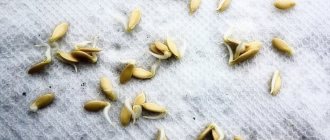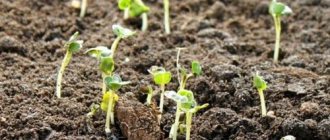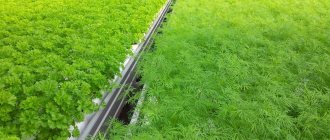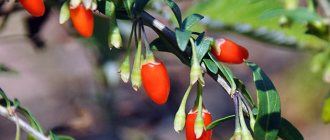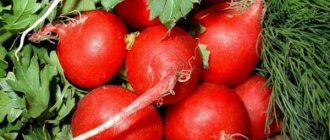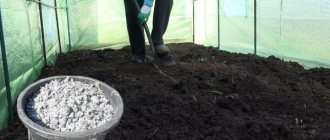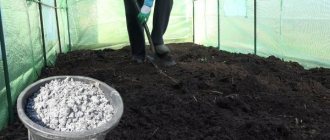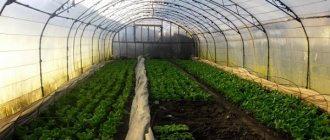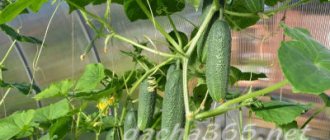4/5 — (2 votes)
Greetings, dear readers. Today we will look at a very interesting and probably familiar root vegetable. Let's read about him on Wikipedia:
Radishes are annual or biennial plants from the Radish genus of the Brassica family. From a classification point of view, radishes are a group of varieties of the species Radish sativum.
That's it, either radish or cabbage. Let's say unequivocally that this is a vegetable and it is the champion in early ripening among root plants: some varieties fully ripen in just three weeks from the moment the seeds are sown. This allows you to plant radishes and harvest them several times per season (3-4 times). It has the greatest practical significance in the first year of the growing season, after the ripening of the root crop used for food. If the plant is not dug up during this period, it will continue to grow, produce flowering shoots, and then fruits with seeds will appear from the flowers. Annual varieties produce both roots and seeds in the first year.
For two-year-olds, everything is different; in the first growing season, only the root crop is formed, and the seeds ripen only the next year. Thus, from planting to seed ripening, it can take from 100 days to six months. This vegetable is eaten as a root vegetable (mainly in salads and okroshkas) and foliage (in salads, okroshkas, soups).
This vegetable is sown throughout Russia in a huge number of ways, and everyone will probably praise their own as the best. And they are the best, not because they are, but because they are more convenient for specific gardeners. It’s like one person prefers to dig with a shovel, while another prefers to dig with a pitchfork. And everyone will argue that it’s better this way. I will not challenge anyone, I just want to show you how to plant radishes, how to grow them, I will give recommendations and advice. And you choose which path you will take in planting it.
Features of growing radishes in a greenhouse
Radish is a member of the cabbage family of the radish genus. According to the growing season, plants are classified into annual and biennial. In the first case, both root crops and seeds are obtained in the year of planting, in the second, fruits are obtained in the year of sowing, but seeds are received only in the next year.
Cultivated in open ground (in beds), in greenhouses, greenhouses. It can grow even... outside the earth's atmosphere.
Interesting fact! As part of the study of plants grown in space, radishes were also selected aboard the orbital station. She has earned such honor because, firstly, she is able to produce a crop in a short period (within 3-5 weeks), and secondly, not only its fruits, but also its leaves are eaten.
The crop shoots appear very quickly, in 2-3 days. The condition of the tops, in which photosynthesis processes take place, affects the quality of root crops. Therefore, when growing radishes in a greenhouse, you need to pay due attention to its above-ground part, even if you do not plan to consume the “tops”.
Lighting
Proper lighting is fundamentally important. With its deficiency, plants are stretched and root crops are not formed. With severe light starvation, the sprouts may die, having already grown 3-4 true leaves. Thickened crops also lead to slight shading, resulting in small radishes. If there is not enough light, but it is warm, only tops grow without root crops.
Excess light is also harmful, it leads to early bolting. With 14 hours of daylight or more, radishes will definitely begin to bloom to the detriment of the harvest. The optimal duration is 8-9 hours per day, the minimum intensity is 1500-2000 lux. The brighter the lighting, the faster the root crops will form.
When to grow radishes in a greenhouse
You can harvest crops in a greenhouse continuously from the first spring month, March, until the last autumn month, November. It is possible to grow even in winter (however, in the northern regions of the country heating is required, but in the middle zone it is desirable to protect against sudden cold snaps).
An unheated greenhouse must be covered with polycarbonate; Sow seeds at the end of October or in November.
What factors influence the ripening time in the shelter?
The greenhouse is an ideal place for seed germination and allows you to extend the natural growing season. Factors influencing the growth period of radishes in a greenhouse:
- Humidity. The humidity level should vary between 70% and 85%. Too much humidity can weaken plants and encourage early fungal diseases. Humidity levels can be reduced through venting. If you need to increase the level, place several containers of water in the greenhouse, it will evaporate, maintaining the humidity level.
- Watering. Be careful - water is necessary, but the amount depends on temperature, day length, plant size and growing environment. Many people recommend watering radishes thoroughly once a day. Use well-drained soil. Too much moisture can lead to root rot.
- Ventilation. Greenhouse plants often need fresh air.
This is one of the most important parts of a greenhouse as it helps regulate temperature, provides plenty of fresh air for photosynthesis, and prevents pest infestation and disease. Stagnant air can become a breeding ground for unwanted pests, fungus, mold and disease, so make sure the greenhouse is well ventilated. Use roof vents to allow moisture and heat to escape naturally. - Variety Most spring radish varieties ripen in less than a month. Late varieties such as China Rose and Long Black Spanish require a longer growing period, but are in many ways superior to mid-season varieties. What varieties of radishes are best grown in a greenhouse are discussed in a separate article.
- Season. The rate of fruit growth is also related to the time of year. In winter, radish growth will be slower than in spring. The difference in the ripening of vegetables in different periods is from 5 to 7 days.
Use greenhouses to extend the growing season. This helps in early planting and late harvesting.
Abundance of radish varieties
Radishes are selected based on the desired color, shape, and growing season. Different varieties have different colors: red, purple, yellow, pink with a white tip, white. The shape of the fruit varies from round, flat-round to oval and spindle-shaped.
Varieties are distinguished according to ripening time:
- Early ripening (growing season up to twenty-five days),
- Medium (thirty-five days),
- Late (up to forty-five days).
If you cultivate one variety, then to ensure uninterrupted production of radishes you need to sow the seeds every couple of weeks. In the case of selecting seeds of varieties that have different growing seasons, planting should be done approximately once a month.
It is necessary to take into account the existence of hybrids marked with the F1 sign on the packaging. They are the most resistant to disease and are especially productive; some have a more pleasant taste. But they are not suitable for growing plants for seeds.
It is worth paying attention to such characteristics of the selected variety as the absence of looseness, bitterness of fruits and bolting of plants, and immunity to diseases. A very valuable quality for greenhouse cultivation is the variety’s tolerance to insufficient lighting.
For example, the following varieties are popular:
- “French Breakfast” (elongated fruits with a two-color color; early ripening, does not form flower “arrows”);
- Hybrids “Celeste F1”, “Irene F1” (Dutch selection; bright red, round shape, early, grow normally in low light conditions, intended for closed ground);
- "Molniya F1", "Okhotsky" - domestic, suitable for planting in greenhouses.
The following radish varieties have proven particularly effective for winter cultivation:
- “Fanal” (after germination, ripens on the 20th day);
- “Sora F1” (large, suitable for uninterrupted cultivation throughout the year);
- "Cherriet F1" (does not shoot, large, without bitterness, voids, gives high yields).
How to grow radishes at home on a windowsill
With the right technology, radishes grow quite successfully in indoor conditions. Caring for a vegetable garden on a windowsill is a little more difficult, but if you follow the rules, you can enjoy fresh fruits all year round.
What to pay attention to.
- We remember that radishes do not like heat. Warm air from central heating can ruin all your hard work, resulting in tasteless and limp fruit. If your radiator does not have temperature control, it is better to move the radish boxes to a cool place and install a lighting system.
- For artificial lighting, use fluorescent lamps. Radishes are sown on a windowsill in natural light at the end of January if the windows are on the south side. If they face east or west - after February 10th.
- Don't forget to water and loosen the plant regularly.
Preparing the soil for planting radishes
Soil preparation is the first stage of greenhouse radish cultivation. Its processing is carried out twice a year, in early spring and in October.
- In the spring, nitrogen fertilizers are applied to the soil according to the instructions (one option is 12-18 grams per 1 sq.m of ammonium nitrate).
- In the fall, dig shallowly, 10-15 centimeters, add humus - from 3 to 4 kilograms per 1 sq.m. You can use potassium salt (15 grams) and superphosphate (50 grams) per 1 square meter or nitroammophoska in accordance with the recommendations.
- It is undesirable to apply manure, as shapeless fruits may form.
- If the soil is heavy, the plant will soon begin to bloom.
Neutral and slightly acidic soils are considered the best. If the soil is too acidic (pH less than 5), it should be limed (to avoid the risk of plant diseases).
Successful predecessors of radishes are legumes, potatoes, tomatoes, cucumbers, and onions. But after its “relatives” - radish and cabbage - on the contrary, it should not be planted, since powdery mildew and mucous bacteriosis are likely to develop.
Temperature
Until the seeds have sprouted, the temperature is maintained at 18-20°. After emergence of seedlings, it is reduced to 5-8° so that the sprouts do not stretch. After a week, the following regime is established:
• in sunny weather – 15-18°,
• on cloudy days – 12-14°,
• at night – 8-10°,
• soil temperature – 12-16°.
Radishes don't like heat. In such conditions, root crops grow flabby, with voids inside. At 24-26° and above they do not form at all. But radishes are quite resistant to cold. Adult plants can tolerate short-term frosts down to -5°, and seedlings - up to -3°.
Sowing radish seeds
Since the period from sowing to harvesting of radishes is short and the vegetable is also resistant to cold, there is no need to grow radish seedlings: the seeds are sown directly on the beds in a greenhouse.
- After fertilizing the soil in the spring, it is loosened. Then the holes or grooves are prepared. Furrows are made at a distance of 10-15 centimeters.
- You can use markers when planting the crop according to the pattern (5x5, 6x6, etc.). The recesses are sprinkled with ash and watered.
- Soaked (in warm water for about 2 hours) and then dried seeds are placed in recesses with a distance of 2-3 centimeters.
- Planting depth is approximately 2 centimeters. The seeds are covered with soil on top and compacted slightly.
To ensure the required temperature conditions, the plantings are covered with film. After the sprouts appear, it is removed.
Spring planting begins at positive soil temperatures (from 0 to 3 degrees), approximately in the 1st decade of March.
Landing
Radishes need fertile, loose, well-moistened soil. It is recommended to fertilize it with humus (4 kg per 1 m2), and add peat to the clay soil. Acidic soil must be neutralized, otherwise radishes may get clubroot.
For 1 m2 you will need 2-4 g of seeds. It is better to take large ones, from 2 mm in diameter. Plants grown from small ones turn out to be weaker and die faster. Seeds are planted to a depth of 1 cm at a distance of 3-6 cm from each other, 2 pieces in each hole. Leave 6-10 cm between the rows. You can sow in a continuous line, but then be sure to thin out the seedlings.
Caring for radishes in a greenhouse
After removing the film, caring for radishes in a greenhouse consists of loosening, watering (10-15 liters of water per 1 sq.m.), thinning (2-5 centimeters between sprouts; otherwise the radishes may bloom and the fruit pulp will be loose), as well as hilling . No need to feed anymore.
As already mentioned, it is important that the radish tops are healthy. In this regard, you need to take care of prevention against cruciferous flea flea. To do this, plantings are powdered (once a week) with a mixture of ash, tobacco dust and lime.
- If the color of the leaves is too pale, the radishes should still be fed a little with a nitrophoska solution (1 tbsp per 10 liters of water; water each meter of crop with 2-3 liters of solution).
- Particular attention should be paid to the temperature regime. Before the sprouts appear, the air should be heated to 20-25 degrees, after which it must be lowered to 5-6 degrees within 3-4 days.
- When the cotyledon leaves unfold (before the real leaves appear), the recommended temperature is 8-10 degrees. After another two days, the temperature is set at 12-18 degrees, and the humidity is 60-70 percent.
In general, seedlings can withstand temperatures down to minus 4 degrees. In winter, if after sowing the air temperature is below -7 degrees, an additional cover with a layer of agrofibre is used.
It is also necessary to take care of sufficient lighting and ventilation of the greenhouse in the cool season (the latter is necessary to protect the plants from fungal diseases).
Disease Prevention
The most common disease of radish is blackleg. The vegetable gets sick due to waterlogging in the greenhouse atmosphere. For prevention, experts recommend treating plants with a mixture of wood ash solution (200 g) and laundry soap (50 g) per bucket of water. The same remedy will repel pests (caterpillars, cabbage moths, midges) from seedlings. You can fight them by pollinating radishes with a mixture of sifted wood ash and tobacco dust.
Radish harvest
Ready root vegetables are harvested every 4-5 days. As a rule, the harvest takes 1-2 weeks.
In general, radishes are not a capricious crop, and with proper care and following recommendations, you can grow a large harvest in a greenhouse. Depending on the selected variety, about one hundred root crops can be harvested from one square meter, the weight of each of which will be from twenty to thirty grams, or from two to three kilograms of radishes.
How does the growth period in a greenhouse differ from the growth period in open ground or at home?
A greenhouse is an enclosed space for growing fruits and vegetables and creates ideal conditions for growing radishes. Growing a plant in a greenhouse speeds up the process several times, this is due to the following reasons:
- Good light distribution inside the greenhouse. Greenhouse covers can change the direction of the sun's rays, thus evenly distributing light over the entire surface.
- Energy efficiency. Takes advantage of environmental conditions such as optimizing heat inside the greenhouse.
- Microclimate control. One of the main advantages of a greenhouse is control and creation of optimal growing conditions. You can adjust temperature, humidity, lighting, etc.
- Protection from diseases, pests and other parasites. Another advantage of a greenhouse is that it is an enclosed space.
- Excellent ventilation. You can quickly ventilate the greenhouse thanks to skylights or side windows.
- Optimal sealing against rain and air.
- Off-season production. Thanks to environmental controls, greenhouses can produce products during the off-season.
- Possibility of production in regions with unfavorable weather conditions.
Photo of proper cultivation of radishes in a greenhouse
Benefits and contraindications
The main benefit is the content of carbohydrates, vitamins, proteins, nitrogenous and ash substances, mineral salts and phytoncides. The largest number of them is found in the leaves.
It improves blood circulation, fights obesity, fiber removes cholesterol, normalizes blood sugar levels, and prevents cancer.
Not recommended for people with serious gastrointestinal problems. In this case, consume it no more than once a week, but it is better to boil it.
